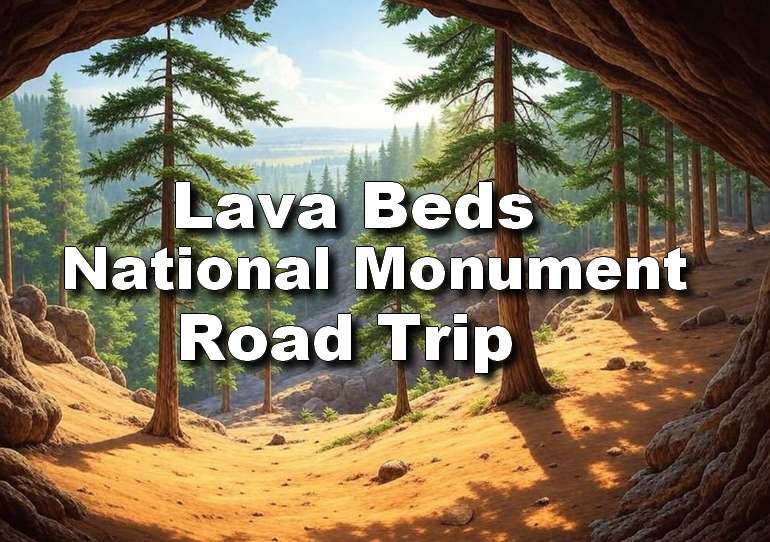- 36
- 38shares
- Like
- X
- Digg
- Tumblr
- VKontakte
- Buffer
- Love This
- Odnoklassniki
- Meneame
- Blogger
- Amazon
- Yahoo Mail
- Gmail
- AOL
- Newsvine
- HackerNews
- Evernote
- MySpace
- Mail.ru
- Viadeo
- Line
- Comments
- SMS
- Viber
- Telegram
- Subscribe
- Skype
- Facebook Messenger
- Kakao
- LiveJournal
- Yammer
- Edgar
- Fintel
- Mix
- Instapaper
- Copy Link

The unique geology of the Lava Beds National Monument results from volcanic eruptions from the Medicine Lake shield volcanoes, which included cinder cones, lava beds, and over 700 lava tubes. The volcanic eruptions were caused by an oceanic plate subsiding under the continental plate. Whether you visit for the geology and history or to immerse yourself in an otherworldly landscape, this Lava Beds provides a fantastic adventure.

Discover Hundreds of Caves and Lava Tubes
One of the significant draws of Lava Beds is the opportunity to explore dozens of developed caves. These caves are the remnants of underground lava streams pushed through the subsurface. After the lava exited, it left behind long tube-like caves. Lava Beds National Monument has the largest concentration of lava tubes in the United States. Many caves offer an opportunity to go subsurface with different difficulty levels, ranging from least to most challenging. Guided tours are available in the summer, but with adequate preparation, most people can enjoy the caves without a guide.

Exploring Lava Beds National Monument Caves
Some good caves have high ceilings and relatively smooth floors, including Valentine Cave, Mushpot Cave, and Merrill Cave. Sentinel Cave is located at the Visitor’s Center and is an accessible cave. There are a few things to remember regarding staying safe in the cave. Wear long sleeves, pants, and closed-toe shoes with sturdy soles. Other essentials for some of the more difficult caves include gloves, knee pads, and a helmet. The surfaces can be uneven and jagged, so it is essential to protect yourself. Also, each person should have a flashlight and an additional light source or batteries.

For Visitors with Speluncaphobia, There are Hiking Trails
Apart from caves, there are hiking trails to explore the volcanic landscape above ground. There are 12 hiking trails at Lava Beds National Monument. Trails range from about a half-mile to nearly ten miles, so there is a trail for everyone. Routes pass through points of historical events and features, as well as geologically exciting places. Pets and bicycles are not allowed on the trails. Take water with you and be ready for changeable weather conditions.

Lava Beds Wildlife and Fauna
When visiting Lava Beds, be prepared to see various plants and animals. One of the most exciting animals in the park is the bat. There are 14 bat species at the park, and robust monitoring and protection efforts exist. The caves are the perfect spot for the bats to roost, raise their young and hibernate. Other mammals range in size from small kangaroo rats to large mountain lions. Birders are drawn to the area for world-class bird watching. Both migratory and year-round resident birds are in the area. Be sure to take binoculars for close-up birdwatching. Plant species in the Lava Beds areas can be just as stunning as the animals’ Wildflower blooms that occur spring through fall, with different plants blooming at other times.

History: Modoc People and the Modoc War
Lava Beds National Monument has been inhabited for thousands of years, as shown by the Native American rock art and archaeological sites in the area. The Modoc War, the only significant conflict with Native Americans in California, was fought in this region. The war was sparked by the proposed forced relocation of the Modoc people to the Klamath Reservation, even though the Modoc and Klamath were historical enemies. The conflict lasted approximately eight months, from November 1872 to June 1873. The war saw 60 Modoc fighters face off against 600 members of the US Army. Ultimately, the casualties included 53 US soldiers, 17 civilians, and 15 Modoc warriors.

Plan Your Visit Lava Beds National Monument
- Campgrounds: Indian Wells campground offers camping in lava beds. It has restrooms and drinking water and is open year-round.
- Hotels: If you prefer non-camping options, you can look for lodging outside the park in Tulelake or check the Alturas Chamber of Commerce of the Klamath Chamber of Commerce.
- Caving: The average temperature in caves is 55 degrees, so dress accordingly. Some caves are also closed seasonally to protect bat populations.
- Visitor Center: The visitor center provides educational resources, including exhibits on the geology, ecology, and history of the area. Ranger-led programs, including cave tours, are often available during peak seasons.
- Accessibility: While some caves are easy to enter, many require physical effort or even spelunking skills. It’s wise to check which caves are accessible to your level of fitness and interest.
- Weather: It can get quite warm in summer, and the terrain can be rugged. Bring water and light sources, and wear sturdy shoes.
- Location: Lava Beds National Monument in northeastern California is a fascinating geological and historical site.
- Address: 1 Indian Well, Tulelake, California.
Northern California Day Trip Ideas
Sunset Crater National Monument
- 36
- 38shares
- Like
- X
- Digg
- Tumblr
- VKontakte
- Buffer
- Love This
- Odnoklassniki
- Meneame
- Blogger
- Amazon
- Yahoo Mail
- Gmail
- AOL
- Newsvine
- HackerNews
- Evernote
- MySpace
- Mail.ru
- Viadeo
- Line
- Comments
- SMS
- Viber
- Telegram
- Subscribe
- Skype
- Facebook Messenger
- Kakao
- LiveJournal
- Yammer
- Edgar
- Fintel
- Mix
- Instapaper
- Copy Link